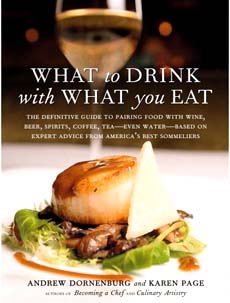

Wonder no more...look it up!
|
KAREN HOCHMAN is Editorial Director of THE NIBBLE™.
|
|
September 2006
|
 |
What To Drink With What You Eat
By Andrew Dornenburg and Karen Page
CAPSULE REPORT: The first book to suggest food and beverage pairings for almost every kind of commonly-eaten food in America—from haute cuisine to casual food to snack food—Dornenburg and Page provide a wealth of information. We wish it had yet more, so we could understand the whys and not just the whats of their pairing suggestions. And we wish the book were better edited and designed. It looks pretty at first glance, but when you try to read it, what should be clear and functional is laborious. Yet, the information put together by the authors is unique—it’s like having a home sommelier. Every food- and wine-lover will want a copy.
As every gastronome knows, food is only part of a great meal: what you drink with what you eat is the other part. And that is the title of this major culinary work by Andrew Dornenburg and Karen Page, whose 2003 work, Becoming a Chef, won a James Beard Award. The subtitle of the book, What To Drink With What You Eat, is: The Definitive Guide to Pairing Food with Wine, Beer, Spirits, Coffee, Tea—Even Water—Based on Expert Advice from America’s Best Sommeliers.
Dornenburg and Page have interviewed some of the top sommeliers in America—at (just a sampling) Alinea, Frontera Grill and Tru in Chicago; French Laundry in Napa; Babbo, Blue Hill, Chanterelle, Daniel, Jean Georges, Per Se and The Modern in New York; Emeril’s in New Orleans; Masa’s and Rubicon in San Francisco; Bern’s Steak House in Tampa; and Inn at Little Washington in Virginia. One of our favorite chapters was reading what 12 bottles the experts would take if banished to a desert island. (We have played that game many times.)
But the reason to buy the book is the tremendous amount of content on matching foods and beverages. The two key sections are what the authors call “tables” (they aren’t) or alphabetical lists (they are). We’re sure there was much debate over what to call them. To us, the simplest and most accurate description is “pairing list”—although each list is 100 pages long.
The first list, called “What To Drink With What You Eat,” matches beverages to hundreds of individual foodstuffs, condiments, spices, and dishes from A (aoli, anchovies, anise, artichokes, avocado...) to Z (zabaglione, zucchini and zucchini blossoms). You look up what you plan to eat and decide what to drink with it—there are numerous matches for almost every food, from breakfast through aprés-dinner, including snacks. The authors do provide general matches as well as by common preparations, e.g., whether the asparagus is grilled, in lemon butter or with hollandaise. You can develop quite an appetite just reading through the list.
On the other hand, if you have a particular libation in mind and want to find a food to pair with it, head to the other list, called “What To Eat With What You Drink.” Whether it’s aquavit or charbono (a full-bodied red from the Piedmont region of Italy), you’ve got suggestions.
- Love your lager? The experts tell you why it goes with spicy Asian, and Caribbean food and barbecue, but not with Mexican. For that, turn back to the food glossary and you’ll even get particular recommendations for empanadas, enchiladas and fajitas. A second glossary lets you choose from the reverse standpoint: select your libation and see what foods pair best with it.
- Drinking only mineral water? Go for Borsec with your caviar or salad, Ramlosa with your steak and San Pellegrino with your chocolate hazelnut torte.
It’s not only useful, it’s fascinating—and you’ll learn about beverages you didn’t know existed to boot.
The book offers a huge amount of information, but like pronouncements from our parents, the information given is “because I said so.” There’s no deeper learning to be had with most of the many hundreds of clusters of suggestions. One thing that is sorely lacking for the serious student of food—and we hope will be corrected in a future edition, even in an appendix—is an explanation of why selections were made. What, for example, do unoaked Chablis but unoaked to slightly oaked Chardonnay, Champagne and other sparkling wines, a gin martini and slightly sweet wine have in common that make them good pairings for mayonnaise? Inquiring food minds want to know.
A nit to pick is that the content has not been well-served by the editors and the design firm that brought the book to completion. It is such a patchwork of sidebars and intercut articles that it distracts the reader from getting through the main chapter material. If one chooses to read right through, one then goes flipping back and forth to try to find the insets one has skipped over. Second, the 200 pages of pairing lists are not user-friendly. The designers employed no device—no large capital letters, no color blocks or bars, no side indexing, no icons—to separate the sections of the alphabet or to relieve the eyestrain. There’s no main index so you know which page to turn to for “C” or “P.” So, flip back and forth some more. It's a chore, especially in the Information Age, when almost everyone is accustomed to typing three words into a search engine to have what they need pop up. More thought should have been employed here.
Nevertheless, one can skip over the lapses and concur that this is a reference book that belongs in any food- or wine-lover’s book collection. We only wish that we could purchase access to an online edition and do quicker searches for the many nuggets of gold.

|




